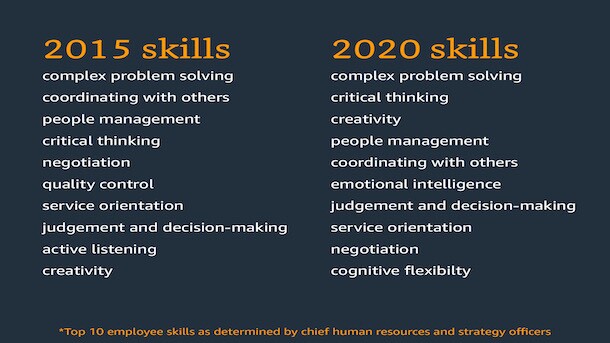As Amazon Future Engineer expands to more than 5,000 schools, benefiting more than 550,000 students each year, the company wanted to further illustrate the need for a computer science education for more students in need. This study explores the need for STEM education for students in underserved and underrepresented communities.
Executive summary
A student's passion for science, technology, engineering, and math (STEM) must be cultivated and nurtured. More importantly, access to STEM must be made available to all. With so much attention given to STEM over the past few years, you would be forgiven for thinking this is now a priority in most schools across America. The reality, however, is quite different.
A student's passion for science, technology, engineering, and math (STEM) must be cultivated and nurtured. More importantly, access to STEM must be made available to all. With so much attention given to STEM over the past few years, you would be forgiven for thinking this is now a priority in most schools across America. The reality, however, is quite different.
While many schools have very basic programs in place, which expand upon rudimentary computer and science classes with years' old curricula, others run optional afternoon clubs and some simply do not have the funds or the teachers to run anything at all.
Another misconception is that schools that use technology, such as iPads and Chromebooks, to teach are at the forefront of STEM. In many schools, technology came in, at best, to replace paper, and COVID-19 has uncovered many of the technological shortcomings schools face around the U.S.
In looking into ways to help foster students' passion for STEM education and computer science (CS) in particular, the most significant cause of concern is the gap in opportunity in underserved communities—where Black and Brown children live in higher numbers—which is continuing to widen.
The number of Black students obtaining STEM degrees has increased over the last two decades, but they remain underrepresented among American science and engineering enterprises and disproportionate to their population size in the U.S. The National Science Board (NSB) estimates that the number of African Americans in science and engineering must more than double to be representative of Black people in the U.S. population in 2030.
Businesses must understand that, with the market for CS professionals projected by the Bureau of Labor Statistics to grow at twice the speed of the rest of the labor market between 2014 and 2024, diversity is not just a nice to have; it is a must-have for business success (National Academies of Sciences, 2018).
Educating parents, especially those of Black and Brown children, about the opportunity STEM and CS education can offer their children starts with showing hard data on the continued growth of these job positions. The Bureau of Labor Statistics shows a median annual salary, in 2019, for CS occupations to be about $48,000 greater than the median wage for all occupations in the U.S.
Long-term success in creating a diverse tech sector will require both the government and corporate social responsibility initiatives from private companies to invest in STEM education for the next generation of workers, while also upskilling the current workforce. This two-pronged approach in necessary to address the skill shortages expected for 2030, as well as the lack of diversity we already face today in tech. Furthermore, providing STEM education to children will never convert them into workers choosing a STEM career unless they see successful people who look like them.
Preparing children for the future of work through STEM
Schools are responsible for developing students' skills and capabilities while also encouraging them to "think differently" and maximize their abilities. However, most schools are not doing this to their full potential today. The reasons rest within curricula that are not keeping up with the rapid pace of change our world is undergoing, teachers who have little support to embrace change, and technology which is thrown in for good measure but often without a clear purpose. In other words, schools continue to operate on fulfilling the needs of an Industrial Age student rather than preparing students for the Information Age.
Schools are responsible for developing students' skills and capabilities while also encouraging them to "think differently" and maximize their abilities. However, most schools are not doing this to their full potential today. The reasons rest within curricula that are not keeping up with the rapid pace of change our world is undergoing, teachers who have little support to embrace change, and technology which is thrown in for good measure but often without a clear purpose. In other words, schools continue to operate on fulfilling the needs of an Industrial Age student rather than preparing students for the Information Age.
Preparing students for the Industrial Age, or a factory economy, meant to focus on uniformity, listening, dependence on leaders, respecting authority, self-sacrifice, lack of initiative, and self-worth. All of these qualities made for ideal factory workers operating as a peg in a broader system. The Information Age, on the other hand, requires a focus on process, collaboration, self-care, mistakes seen as part of growth, initiative, communication, risk-taking, focus on positive, qualities that fit into a work environment that requires adaptability, problem-solving, and multi-tasking.
The World Economic Forum produced a report in early 2017 titled: "The Future of Jobs." The report considered what the employment landscape would look like in 2020. After talking to chief human resources and strategy officers from leading global employers, the authors listed the top 10 skills for 2020 and compared them to what was required in 2015:

This was, of course, before COVID-19 and the sharp pivot into real digital transformation we have seen many companies embrace. Kids will have to be ready for what the World Economic Forum calls the "Fourth Industrial Revolution," which is characterized by a fusion of technologies blurring the lines between the physical, digital, and biological spheres creating huge opportunity as well as risk." It is the current and the developing environment in which disruptive technologies from robotics to artificial intelligence and virtual reality are changing the way we live and work. Unlike in past economic revolutions, training will shift from a pre-employment activity to a life-long one. The pandemic has already started a strong training wave as workers who lost their jobs attempt to re-skill.
Young people across the globe have been impacted the most by the pandemic, with the International Labor Organization (ILO) estimating that one in six young people has stopped working since the start of the COVID-19 pandemic. In 2019, youth unemployment was already higher than in other groups at 13.6%. Almost 267 million young people worldwide were not in employment, education, or training. Those employed were also more likely to be in jobs that left them more vulnerable, such as informal sector work, migrant work, or lower-paid occupations.
The Bureau of Labor Statistics had projected that by the end of 2019, there would be a need for 1.9 million STEM-educated professionals in the U.S., but only roughly 40% of students, who intend to do a major in STEM end up not switching to other subjects.
Another report released in 2015 by The Programme for International Student Assessment (PISA) placed the U.S. as the 38th country in math and 24th in science out of 73 countries. Begun in 2000 and conducted every three years, the PISA was created to measure the performance of 15-year-old students in science, math, and reading literacy in the 35 industrialized countries of the Organization for Economic Cooperation and Development.
Members of the American Association for the Advancement of Science found that just 16% considered American K-12 STEM education above average; 46% said it was below average when compared to other countries.
More recent data from the Nation's Report Card shows that among 297,000 students across the nation who took part in the 2019 mathematics assessment, most states show no score change in both fourth and eighth grade when compared to the 2017 results.
Even more concerning is to know that, prior to the COVID-19 pandemic, STEM jobs were projected to increase 1.7 times faster than non-STEM careers, with top companies struggling to find professionals with the right skills to fill those positions.
When we look at the biggest tech competitor to the U.S—China—STEM numbers look much healthier. According to the World Economic Forum, 40% of Chinese graduates finished a degree in STEM in 2019—twice the number of American grads.
Parents who play a strong role in guiding their children's interests and professional direction hold some misconception on who should study STEM-related subjects. According to a 2016 Gallup study, more than 80% of American parents surveyed think that computer science is as important as any other discipline, but 57% of them believe that one must be “very smart” to learn CS. When STEM classes are offered as an afternoon activity rather than being integrated into the official school program, they are often in competition with sports. This particularly impacts Black students whose parents often see sports scholarships as an opportunity to grant their children a college education.
STEM and diversity
Diversity makes a difference in any business and any role, but it becomes critical when promoting innovation. Each person brings a diverse set of experiences and perspective to the job and the team they're a part of, elevating the critical thinking and problem-solving skills. From a talent perspective, both the government and private businesses need to consider what other countries are doing. The World Economic Forum highlights Eastern Europe and Central Asia for their gender parity in science dating back to the Soviet Union's influence in actively encouraging female participation in science. Northern Europe achieves gender equality thanks to the strong welfare policies that support women in the workplace.
Diversity makes a difference in any business and any role, but it becomes critical when promoting innovation. Each person brings a diverse set of experiences and perspective to the job and the team they're a part of, elevating the critical thinking and problem-solving skills. From a talent perspective, both the government and private businesses need to consider what other countries are doing. The World Economic Forum highlights Eastern Europe and Central Asia for their gender parity in science dating back to the Soviet Union's influence in actively encouraging female participation in science. Northern Europe achieves gender equality thanks to the strong welfare policies that support women in the workplace.
A report published by Pew Research Center in 2018 showed that most Black and Hispanic employees working in STEM in the U.S. felt that primary underlying reasons for underrepresentation in STEM are rooted in the lack of educational opportunities. Some 52% of those with a STEM job say a major reason for this underrepresentation is because Black and Hispanic children and young adults are less likely to have access to quality education with a strong STEM foundation. Another 45% attributed these disparities to these groups not being encouraged at an early age to pursue STEM-related subjects.
At the same time, around a third of all panelists working in STEM attributed the underrepresentation of Black and Hispanic employees in STEM to these groups not believing in their ability to succeed in these fields because of lack of encouragement (34%), the lack of role models that looked like them in these fields (32%), and racial/ethnic discrimination in recruitment, hiring, and promotions (32%).
This data speaks to some of the challenges to find a diverse set of educators but the problem is much broader. In the the U.S. several studies point to a lack of qualified CS teachers as a whole. In 2019, in a survey of American pre-service elementary school teachers, only 10% said they understood the concept of computational thinking.
A 2016 report by Georgetown University said that, while the number of African Americans going to college has never been higher, African American college students are more likely to pursue majors that lead to low-paying jobs. African Americans who earned a Bachelor's degree in a STEM-related major, such as architecture or engineering, can earn as much as 50% more than African Americans who earned a bachelor's degree in art or psychology and social work.
African Americans only account for 8% of general engineering majors, 7% of mathematics majors, and 5% of computer majors. Even those who do major in high-paying fields typically choose the lowest paying major within them. For example, the majority of Black women in STEM usually study biology, the lowest paying of the science discipline. Among engineers, most Black men study civil engineering, the lowest paying in that sector.
Another interesting point the report raises is that African Americans who have strong community-based values enter into college majors that reflect those values. Despite comprising just 12% of the population, African Americans are 20% of all community organizers.
Incorporating elements of community service into STEM careers will increase the appeal to African American students and will be a way for tech to be more visible in those communities. For instance, for STEM degrees that have a project-based assessment, colleges could consider a project that benefits the community to which the students belong. This can become a positive circle of evangelization but needs to start with Black students seeing the opportunity first. To grasp the full weight of the need for diversity, we should consider that Black and Hispanic employees made up around a quarter (27%) of the overall U.S. workforce as of 2016. Still, together they accounted for only 16% of those employed in a STEM occupation.
Race and ethnicity are not the only barriers to pursuing careers in STEM. Gender also plays a significant role, with women consistently being underrepresented as well. Pew Research Center analysis of U.S. Census Bureau data from 1990 to 2018 shows that while jobs in STEM have grown substantially, particularly in computer science occupations, the share of women working in STEM jobs has remained at about half that of men over time.
Similar to the Georgetown University report, Pew Research Center also found that the various occupations within the broad STEM classification are not all equally considered by women.
Women make up the majority of those working in health-related occupations but just 14% on average of those in higher-paying engineering jobs. In the fastest-growing category of computer occupations, which includes computer scientists, systems analysts, software developers, information systems managers, and programmers, women's representation had decreased from 32% in 1990 to 25% in 2018.
It is clear, looking at these numbers, that something more needs to be done, starting with providing higher quality STEM education. Quality STEM education is not just about having access to technology and a science lab. It also means access to teachers and mentors who you can relate to either because they look like you or because they come from your community. The need for racially and ethnically diverse mentors was mentioned in previous Pew Research Center studies as a reason to explain this level of underrepresentation in STEM professions, and the same applies to female representation.
It is also important for STEM education to start early in elementary school and continue through high school. College should not be the only entry point to preparing for a career in STEM. Many studies find that Black and Brown young people are less likely to attend college and, when they do, may be disproportionately impacted by factors such as the higher cost of STEM-based courses like engineering or academic advising practices that push students of certain genders or races into particular majors, which discourage them from the field.
Some large tech companies, like Google, have responded by changing their hiring practices to end their requirement for a degree for some technical jobs and are considering candidates with hands-on experience through boot camps and vocational courses. If more companies followed this example, they would open up the opportunity to have a more diverse workplace by widening the hiring pool. Such a move is not just good for increasing diversity, but also to ensure that the people you hire have the most up-to-date skills. Especially when it comes to technology, the speed of innovation moves so fast that your skills might need a refresh by the time you end your four-year degree.
We can provide quality STEM education. We can address the leaky pipeline that is responsible for girls' loss of interest in STEM degrees by giving support and strong mentors. We can get a more diverse set of workers in the workplace. By taking all these steps, we would address the diversity issue, but the inclusion and equity issues remain. Companies must focus on providing equal pay, offering equal career opportunity, and fostering an environment where microaggressions and more blatant harassment are not tolerated. This and more will drive retention, assuring that, as the next generation of STEM employees comes in, the proportion of women and underrepresented groups should only grow.
STEM upskilling to further diversity in tech roles
When we consider who could benefit from high-quality STEM education, we should not just be thinking about the next generation. The current workforce also needs a more diverse set of workers in STEM fields. The need to acquire new digital skills that better prepare the workforce for the workplace of the future might have accelerated during COVID-19, but the writing has been on the wall for many years. Providing STEM courses to current employees might help train (or retrain) them to learn a new skill and pursue a promotion or a change in career.
When we consider who could benefit from high-quality STEM education, we should not just be thinking about the next generation. The current workforce also needs a more diverse set of workers in STEM fields. The need to acquire new digital skills that better prepare the workforce for the workplace of the future might have accelerated during COVID-19, but the writing has been on the wall for many years. Providing STEM courses to current employees might help train (or retrain) them to learn a new skill and pursue a promotion or a change in career.
A few years ago, LinkedIn operationalized all the data on available jobs, their required skills, and the existing skills of job seekers and created the Economic Graph. The graph is a digital representation of the global economy based on more than 690 million professionals, 50 million companies, 11 million job listings, 36,000 defined skills, and 90,000 schools. The Economic Graph makes it possible to spot in-demand skills, emerging jobs, and global hiring rates. As part of a Microsoft-driven upskilling initiative, LinkedIn identified 10 jobs that are in-demand in today's economy and are well positioned to continue to grow in the future. These 10 jobs offer the highest number of job openings, have had steady growth over the past four years, pay a livable wage, and, critical for this moment in time, have skills that can be learned online. Notably, five out of these 10 jobs are STEM-related: Data analyst, software developer, IT administrator, IT support, and digital marketing specialist. Upskilling provides opportunities for women and underrepresented groups in the workforce to improve their career and livelihood outside of the workplace while turning them into role models for the next generation.
Conclusion
In its fullness, STEM education is the foundation upon which future generations will build their success. This is because the skills gained from STEM extend beyond those needed to learn and be successful only in STEM fields. Kids who are successful in STEM master problem solving, critical thinking, productivity, project management, media and technology literacy, leadership, decision-making, negotiating skills, and acceptance of failure.
In its fullness, STEM education is the foundation upon which future generations will build their success. This is because the skills gained from STEM extend beyond those needed to learn and be successful only in STEM fields. Kids who are successful in STEM master problem solving, critical thinking, productivity, project management, media and technology literacy, leadership, decision-making, negotiating skills, and acceptance of failure.
Innovation and research thrive from group efforts rather than individual achievements, which makes diversity a critical ingredient to achieve excellence in all STEM-related areas. According to the National Center for Women & Information Technology, between 1980 and 2010, mixed-sex teams file over 40% more patents compared to all-male teams. Not providing a diverse and inclusive environment will only result in a loss of talent, opportunity, and progress.
Some clear steps can be taken today to make STEM a better career choice for women and underrepresented groups:
- Fund schools in communities with a large proportion of Black and Brown students to nurture the pipeline.
- Help make teachers and educators accountable for encouraging and rewarding girls and children from underrepresented groups in learning STEM-related skills.
- Address bias in college and job applications for STEM courses and majors that put underrepresented groups at a disadvantage, and make tuition costs more accessible.
- Tailor upskilling STEM courses to women and underrepresented groups so the kids of tomorrow can have more role models in today's workplace.
If fostering diversity and inclusion in a corporate environment is good for business, it is clear that promoting diversity and inclusion in STEM education is good for the future of tech innovation in America.
References
Women in Computer Science: Getting involved in STEM https://www.computerscience.org/resources/women-in-computer-science/
Women in Computer Science: Getting involved in STEM https://www.computerscience.org/resources/women-in-computer-science/
Why aren't there more women engineers? http://www.paristechreview.com/2010/09/29/why-more-women-engineers/
5 Numbers That Explain Why STEM Diversity Matters to All of Us https://www.wired.com/brandlab/2015/05/5-numbers-explain-stem-diversity-matters-us/
Diversity in STEM: What It Is and Why It Matters
https://blogs.scientificamerican.com/voices/diversity-in-stem-what-it-is-and-why-it-matters/
https://blogs.scientificamerican.com/voices/diversity-in-stem-what-it-is-and-why-it-matters/
What is the Value of STEM in Education
https://www.invent.org/blog/trends-stem/value-stem-education
https://www.invent.org/blog/trends-stem/value-stem-education
Cultivating Institutional Transformation and Sustainable STEM Diversity in Higher Education through Integrative Faculty Development https://www.researchgate.net/profile/Joseph_Whittaker/publication/263473010_Cultivating_Institutional_Transformation_and_Sustainable_STEM_Diversity_in_Higher_Education_through_Integrative_Faculty_Development/links/55071e660cf2d7a28122f706/Cultivating-Institutional-Transformation-and-Sustainable-STEM-Diversity-in-Higher-Education-through-Integrative-Faculty-Development.pdf
Advancing evaluation of STEM efforts through attention to diversity and culture
https://www.researchgate.net/profile/Donna_Mertens/publication/227736920_Advancing_evaluation_of_STEM_efforts_through_attention_to_diversity_and_culture/links/5b29726c0f7e9b1d00461bf2/Advancing-evaluation-of-STEM-efforts-through-attention-to-diversity-and-culture.pdf
https://www.researchgate.net/profile/Donna_Mertens/publication/227736920_Advancing_evaluation_of_STEM_efforts_through_attention_to_diversity_and_culture/links/5b29726c0f7e9b1d00461bf2/Advancing-evaluation-of-STEM-efforts-through-attention-to-diversity-and-culture.pdf
Using implicit bias training to improve attitudes toward women in STEM https://www.uwo.ca/bmi/wwins/events/Jackson-et-al.-2014.pdf
Reimagining the Pipeline: Advancing STEM Diversity, Persistence, and Success STACY-ANN A. ALLEN-RAMDIAL AND ANDREW G. CAMPBELL
Scientists initiate grassroots efforts to show importance of STEM to U.S. government
https://www.cambridge.org/core/services/aop-cambridge-core/content/view/C6F2E013BC89C276CD841605B03AE20D/S0883769417001737a.pdf/scientists_initiate_grassroots_efforts_to_show_importance_of_stem_to_us_government.pdf
https://www.cambridge.org/core/services/aop-cambridge-core/content/view/C6F2E013BC89C276CD841605B03AE20D/S0883769417001737a.pdf/scientists_initiate_grassroots_efforts_to_show_importance_of_stem_to_us_government.pdf
The Importance of STEM Education in the Elementary Grades: Learning from Pre-service and Novice Teachers' - Perspectives Electronic Journal of Science Education Vol. 20, No. 5 (2016) Lauren Madden, The College of New Jersey, United States James Beyers, The College of New Jersey, United States Steve O'Brien, The College of New Jersey, United States
African American College Majors Earnings
https://1gyhoq479ufd3yna29x7ubjn-wpengine.netdna-ssl.com/wp-content/uploads/AfricanAmericanMajors_2016_web.pdf
https://1gyhoq479ufd3yna29x7ubjn-wpengine.netdna-ssl.com/wp-content/uploads/AfricanAmericanMajors_2016_web.pdf
NAEP Mathematics Assessment https://www.nationsreportcard.gov/highlights/mathematics/2019/
Gender equality in STEM is possible. These countries prove it. https://www.weforum.org/agenda/2019/03/gender-equality-in-stem-is-possible/
What do we need to know about the expansion of K-12 computer science education?
https://www.brookings.edu/research/what-do-we-know-about-the-expansion-of-k-12-computer-science-education/
https://www.brookings.edu/research/what-do-we-know-about-the-expansion-of-k-12-computer-science-education/
Building Computational Thinking https://brill.com/view/book/edcoll/9789004399990/BP000017.xml
Trending news and stories









